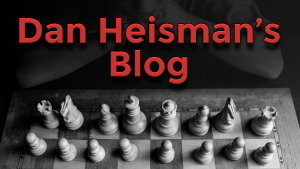When I get asked generic questions on the show about improvement, there's about an 80% chance that I already have at least one Novice Nook containing a much more comprehensive answer than I could easily cover on the air. This, of course, makes me wonder why those viewers are not regular readers of my column at http://danheisman.home.comcast.net/~danheisman/Articles/Novice_Nook_Links.htm since that will help them more than my short answers on the show likely can. But it also means that questions I can't answer with a reference are a lot more interesting.
One was whether Magnus Carlsen could ever get to a 2900 rating. I actually saw online players speculating about 3000 for the Norwegian, but that latter milestone would require even more inflation of FIDE ratings than we have had over the past 35 years. Believe it or not, when Spassky defended his World Championship title against Fischer in 1972, his rating was "only" 2690, which was thirty points higher than the previous champion, Tigran Petrosian, had when he held the title. Today at 2690 rating would not even get you a spot on the "Live" rating list. So my answer was, barring inflation, I thought 2900 would be tough. If Magnus kept going strong, I guessed a peak of 2891. This guess will probably end up being either nearly right or clearly wrong  .
.
Another question was on the classic book Pawn Power in Chess by Hans Kmoch. I learned something as one viewer said there now is an algebraic version of the book. I suggested readers not worry about the arcane definitions in the front of the book - it's a great book even if you don't ever remember that Kmoch labels a weak white square complex as leucopenia. There will not be any quizzes at the back of the book or any time later. Some of his nomenclature stuck a little. For example, a ram as two pawns against each other:
Another would be a lever, where two pawns attack one another, such as after 1.e4 d5. But the seemingly more complex "liberating lever", which is a lever made against a fixed pawn, is now represented by the much more common term "pawn break", or just "break move". One easy example of that is the Queen's Gambit 1.d4 d5 2.c4, where c4 represents the break move. A highly recommended read.
During the show, one question invoked the idea of the Improvement Feedback Loop, which can be represented pictorally by a triangle with three points:
- Chess study, such as puzzles or game books
- Chess play, including mostly playing slowly in long-time control games but also fast play
- Feedback on your play from opponents, strong players, instructors and, for a narrow group of issues, computer engines.
In regular school this would usually be represented by classroom instruction, homework/tests, and reviewing homework/tests.
If you are trying to improve and leave out one of the parts of the triangle, usually the third part (feedback), then it will often leave you wondering why you are not improving as steadily as you might. I should reiterate that opponents are often a great source of feedback, even if they are not as strong as you are (but certainly when they are stronger). They might know some things you don't, or at least be a source of what others are thinking during a game, which eventually is valuable information.
In my experience, there is a strong correlation between rating and the willingness to review the game afterward (assuming there is time to do so, of course). My students have consistently reported that their weaker opponents are almost always unwilling to review a game but, as the opposition improves, the chance that the opponent will realize the value of a post-mortem increases, too.
Whenever I relate this importance of post-mortems to someone, I am reminded of a game at a strong CCA tournament here in Philadelphia that SM Dan Yeager played against GM Finegold. Afterwards, as expected, the two were reviewing the game in great detail in the Skittles room, with the GM offering advice and the teen eagerly absorbing it. I wandered by and was watching for a while when I felt the urge to make a comment about a line they were reviewing. GM Finegold gave me a stare and said "Who are you?" It was only after I assured him I was a master and Dan's coach when he was younger that the GM reluctantly allowed me to stay. But after that I didn't say much more, if anything at all...

.
I often get asked why I don't play competitively any more. One strong reason is that I work at chess six days a week (lessons, TV shows, books, columns,
Tip of the Day on Twitter) so it's very difficult to make your profession your hobby too. Instead I play Heroes of Might and Magic III, WOG version to relax. Still a strategy game but a different one

.
As for the upcoming FIDE World Championship in mid-March, on the show I did a little bookmaking and made Magnus Carlsen about even money against the other seven in the field. Even that may be conservative. The way he is playing I would be surprised (and a little unhappy) if he does not win and challenge Anand later in the year. And given Anand's age (old for a modern World Champion), I would not be at all surprised if we have a new World Champion soon. Lasker's record of 27 years as World Champion (1894-1921) would be very difficult to surpass these days when you have to defend your title regularly and can't pick your own opponents!
Someone asked about defending against the English Opening 1.c4. Since I now play the English, that seemed right up my alley and I showed them a few main defenses. One was the Fischer Variation in the Symmetric English:
----
This line, where Black eventually develops his king's knight to e7, so as to keep control over the d4 square, has been a tough nut to crack at the GM level. White, of course, doesn't have to play into this line - he could play 2.Nf3 and 3.d4, but he often does play it as shown the diagram. The Fischer line leads to complex maneuvering where both sides have chances. But isn't that just what Black would often be quite happy to achieve?
See you in two weeks, when the show will once again be open to all Chess.com members.
 .
. .
. .
.





